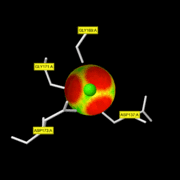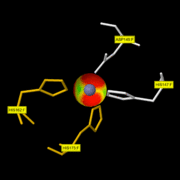Sandbox Reserved 1125
From Proteopedia
(Difference between revisions)
| Line 65: | Line 65: | ||
It is not clear how the hemopexin domain help to cleave triple-helical collagens because the isolated hemopexin domains of MMP-8 does not bind to collagen.<ref>PMID:8489511</ref> | It is not clear how the hemopexin domain help to cleave triple-helical collagens because the isolated hemopexin domains of MMP-8 does not bind to collagen.<ref>PMID:8489511</ref> | ||
The binding of collagenases to collagen must partially unwind triple helix to allow cleavage of the individual alpha chains. Since heat-denatured collagens (gelatins) are poorer substrates at 37°C <ref>PMID:6270090</ref>, interaction of collagenase to interstitial collagen must induce conformational change in alpha chain of collagen that fits the substrate binding site of the catalytic domain, but the molecular basis of this mechanism is not known. | The binding of collagenases to collagen must partially unwind triple helix to allow cleavage of the individual alpha chains. Since heat-denatured collagens (gelatins) are poorer substrates at 37°C <ref>PMID:6270090</ref>, interaction of collagenase to interstitial collagen must induce conformational change in alpha chain of collagen that fits the substrate binding site of the catalytic domain, but the molecular basis of this mechanism is not known. | ||
| + | <font color='red'>In this model the peptide lies antiparallel to the edge strand IV by forming a number of hydrogen bonds. The N-terminal Pro at P3 (the third residue on the left of the scissile bond) interacts with the hydrophobic cleft formed by side chains of His162, Ser151, and Phe164, whereas Leu at P2 (the second residue on the right of the scissile bond) interacts with a shallow groove lined by His201, Ala206 and His207. The dominant interactions between the peptide and the enzyme are made by the phenyl side chain of the inhibitor and the large hydrophobic S1' pocket (located to the right of the catalytic zinc) formed by side chains of His197, Val194, Tyr219, and the main chain segment of Pro217-Asn-Tyr219. The side chain of P2� Ala points away from the enzyme and the C-terminal, P3� Gly is located crossover segments Gly158-Leu160 and Pro217-Tyr219.</font> | ||
| + | |||
Revision as of 10:35, 28 January 2016
MMP8
MMP-8, also called, Neutrophil collagenase or Collagenase 2, is a zinc-dependent and calcium-dependent enzyme. It belongs to the matrix metalloproteinase (MMP) family which is involved in the breakdown of extracellular matrix in embryonic development, reproduction, and tissue remodeling, as well as in disease processes, such as arthritis and metastasis. The gene coding this family is localized on the chromosome 11 of Homo sapiens .[1]
| |||||||||||
References
- ↑ "MMP8 matrix metallopeptidase 8 (neutrophil collagenase)"
- ↑ Stams T, Spurlino JC, Smith DL, Wahl RC, Ho TF, Qoronfleh MW, Banks TM, Rubin B. Structure of human neutrophil collagenase reveals large S1' specificity pocket. Nat Struct Biol. 1994 Feb;1(2):119-23. PMID:7656015
- ↑ 3.0 3.1 Pdf
- ↑ Hirose T, Patterson C, Pourmotabbed T, Mainardi CL, Hasty KA. Structure-function relationship of human neutrophil collagenase: identification of regions responsible for substrate specificity and general proteinase activity. Proc Natl Acad Sci U S A. 1993 Apr 1;90(7):2569-73. PMID:8464863
- ↑ Knauper V, Osthues A, DeClerck YA, Langley KE, Blaser J, Tschesche H. Fragmentation of human polymorphonuclear-leucocyte collagenase. Biochem J. 1993 May 1;291 ( Pt 3):847-54. PMID:8489511
- ↑ Welgus HG, Jeffrey JJ, Eisen AZ. Human skin fibroblast collagenase. Assessment of activation energy and deuterium isotope effect with collagenous substrates. J Biol Chem. 1981 Sep 25;256(18):9516-21. PMID:6270090
- ↑ "Neutrophil collagenase"
- ↑ "Metalloendopeptidase activity"
- ↑ "Extra Binding Region Induced by Non-Zinc Chelating Inhibitors into the S1′ Subsite of Matrix Metalloproteinase 8"
RESSOURCE : Image:2oy4 mm1.pdb ( la structure du monomère )


